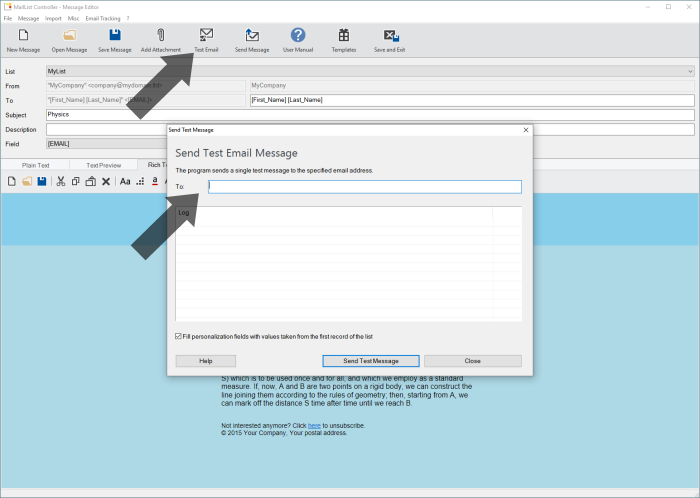Spam Rating
Why is my Message detected as Spam and how can I avoid it?
Today almost all mail boxes are protected by some kind of anti-spam filter. Client based filters are part of most mail clients and most anti-virus programs contain additional plug-ins for popular mail clients like e.g. MS Outlook. Server based filters can move a message to the junk folder (or reject the message) even before the message is received by the client anti-spam filter at all.
check MailList Controller sends email messages in the same format as your email client.
check The message encoding or the mailer itself is not the problem.
warning In most cases the content of the message or the email account is the reason why a newsletter message gets detected as spam.
The Community:
Large mail provider like e.g. gmail.com or outlook.com are using sophisticated spam detection technologies, complex filter rules and most important: the community. Also many client based filters (plug-ins) include the community. If many recipients interact with your messages in a positive way by opening, reading or clicking on a link, then it's more likely that your message is not spam. On the other side, if most recipients mark your message as spam, there is a high chance that your message ends up in the junk folder.
warning Send high quality content to your subscriber
warning Personalize the message, e.g. use "Hello [Name]" instead of "Hello"
warning Add an unsuscribe link to your newsletter - it's better as getting marked as spam
warning Don't flood your subscriber's mail box with too many messages
warning Make sure the message is still readable if images are blocked by the recipient's mail client
warning Focus on the message (image) size - many people are using mobile devices to read their mails
Message Content and Subject:
warning Do NOT try "dirty tricks" like useless filler text, misleading subject lines, misleading anchor texts, etc.
warning Avoid typical spam terms like "business offer"
warning Avoid excessive use of HTML code and don't use HTML5
warning Avoid <div> and deeply nested tables
warning Don't over-optimize your HTML code
warning Don't use Javascript, Flash, embedded video, iframes, forms or external CSS code - it won't work at all, but could harm the spam rating
warning Don't use tracking pixels or web bugs
warning Avoid inline images with only a few words of text
warning Avoid too many links in your mail
Email Marketing and Newsletters made easy
Arclab MailList Controller is the complete solution for newsletter mailings
and email marketing campaigns.
Software for Windows PC - No subscriptions - No recurring fees
List Email Address and Outgoing Mail Server (SMTP Server)
warning Make sure the specified list email address belongs to the outgoing mail (SMTP) server!
This issue is very important - if the sender email is from a different provider, then you will be blocked by most anti-spam filters or the message will be rejected by the outgoing mail server.
warning Use SSL (Port 465) or StartTLS (Port 587)
The mail header includes the route from the sender's client to the recipient's client.
warning Use Sender Policy Framework (SPF) or Domain Keys Identified Mail (DKIM)
Today many mail server support the Sender Policy Framework (SPF), as
defined in RFC 4408, or use the Domain Keys Identified Mail (DKIM) for associating
a domain name to an email. SPF and DKIM are server based - it's not required
to change or setup anything in MailList Controller.
"SPF is used
to describe what mail server is allowed to send messages for a domain".
This means it's used to detect fake email addresses (as sender email
address).
More Information
about the Sender Policy Framework (SPF) by OpenSPF.org
"Domain
Keys Identified Mail (DKIM) is a method for associating a domain name to
an email, thereby allowing an organization to take responsibility for a
message in a way that can be validated by a recipient." ... from
Wikipedia.org
In other words (simplified): "Some organization (domain) has signed
the message and is responsible for it".
Test your Message
It's recommended to send a few test messages to spam-protected email
accounts and web mail accounts to verify the spam rating of the message.
Open the internal editor, click on "Test
Email", enter your email address (in To) and send a test email.
Important:
Send out newsletters to subscribers
only and allow them to unsubscribe! Adding an unsubscribe link is easy
and takes only a few seconds.
See also:
How to add an unsubscribe
link to your newsletter

Common Issues:
The header often contains details about the spam-rating:
e.g.
1.1 MPART_ALT_DIFF BODY: HTML and text
parts are different
Include a plain-text part to your HTML message.
(use the "Extract ..." function)
1.2
TVD_FW_GRAPHIC_NAME_MID BODY: TVD_FW_GRAPHIC_NAME_MID
Rename the inline
image e.g. use 1.gif instead of header.gif
1.4 SARE_GIF_ATTACH FULL: Email has a inline
gif
Use a different format e.g. PNG instead of the GIF image.
0.8 HTML_TITLE_SUBJ_DIFF HTML_TITLE_SUBJ_DIFF
Replace the title tag in the html source code. (remove <title> ... </title>)
1.3 MISSING_SUBJECT Missing Subject:
header
Add a subject to your message
1.7 SARE_GIF_STOX Inline Gif with little
HTML
Add more text/html content or replace/remove image.
0.6 HTML_IMAGE_RATIO_02 BODY: HTML has
a low ratio of text to image area
2.5 HTML_IMAGE_ONLY_16 BODY: HTML: images
with 1200-1600 bytes of words
Add more text/html content or remove
image.
1.6 MY_CID_AND_CLOSING SARE
cid and closing
1.5 MY_CID_AND_STYLE SARE cid and style
1.6 MY_CID_ARIAL2_CLOSING
SARE cid arial2 closing
1.6 MY_CID_ARIAL_STYLE SARE cid arial2 style
1.5 MY_CID_AND_ARIAL2 SARE CID and Arial2
Remove style/font tags (<div>,</div>,<font>,</font>)
before and after the <img ...> tag.
If its not possible ... try to
change the font e.g. use MS Sans Serif instead of Arial.
See also: How to read and analyze the email header fields of a message